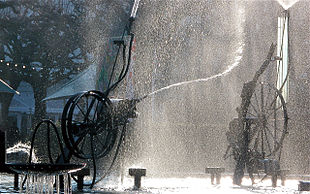
Dada or Dadaism was an art movement of the European avant-garde in the early 20th century, with early centres in Zürich, Switzerland, at the Cabaret Voltaire, founded by Hugo Ball with his companion Emmy Hennings, and in Berlin in 1917. New York Dada began c. 1915, and after 1920 Dada flourished in Paris. Dadaist activities lasted until the mid 1920s.
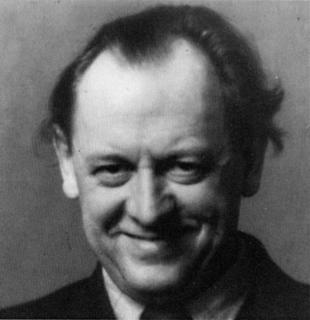
Kurt Hermann Eduard Karl Julius Schwitters was a German artist who was born in Hanover, Germany.

Tristan Tzara was a Romanian avant-garde poet, essayist and performance artist. Also active as a journalist, playwright, literary and art critic, composer and film director, he was known best for being one of the founders and central figures of the anti-establishment Dada movement. Under the influence of Adrian Maniu, the adolescent Tzara became interested in Symbolism and co-founded the magazine Simbolul with Ion Vinea and painter Marcel Janco.

In the arts and in literature, the term avant-garde identifies a genre of art, an experimental work of art, and the experimental artist who created the work of art, which usually is aesthetically innovative, whilst initially being ideologically unacceptable to the artistic establishment of the time. The military metaphor of an advance guard identifies the artists and writers whose innovations in style, form, and subject-matter challenge the artistic and aesthetic validity of the established forms of art and the literary traditions of their time; thus how the artists who created the anti-novel and Surrealism were ahead of their times.

Fluxus was an international, interdisciplinary community of artists, composers, designers and poets during the 1960s and 1970s who engaged in experimental art performances which emphasized the artistic process over the finished product. Fluxus is known for experimental contributions to different artistic media and disciplines and for generating new art forms. These art forms include intermedia, a term coined by Fluxus artist Dick Higgins; conceptual art, first developed by Henry Flynt, an artist contentiously associated with Fluxus; and video art, first pioneered by Nam June Paik and Wolf Vostell. Dutch gallerist and art critic Harry Ruhé describes Fluxus as "the most radical and experimental art movement of the sixties".
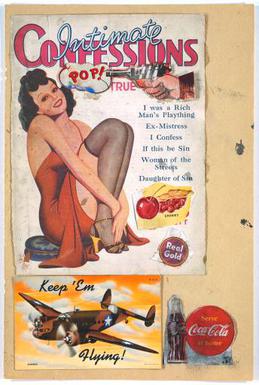
Pop art is an art movement that emerged in the United Kingdom and the United States during the mid- to late-1950s. The movement presented a challenge to traditions of fine art by including imagery from popular and mass culture, such as advertising, comic books and mundane mass-produced objects. One of its aims is to use images of popular culture in art, emphasizing the banal or kitschy elements of any culture, most often through the use of irony. It is also associated with the artists' use of mechanical means of reproduction or rendering techniques. In pop art, material is sometimes visually removed from its known context, isolated, or combined with unrelated material.

Postmodern art is a body of art movements that sought to contradict some aspects of modernism or some aspects that emerged or developed in its aftermath. In general, movements such as intermedia, installation art, conceptual art and multimedia, particularly involving video are described as postmodern.

Daniel Spoerri is a Swiss artist and writer born in Romania. Spoerri is best known for his "snare-pictures," a type of assemblage or object art, in which he captures a group of objects, such as the remains of meals eaten by individuals, including the plates, silverware and glasses, all of which are fixed to the table or board, which is then displayed on a wall. He also is widely acclaimed for his book, Topographie Anécdotée* du Hasard, a literary analog to his snare-pictures, in which he mapped all the objects located on his table at a particular moment, describing each with his personal recollections evoked by the object.
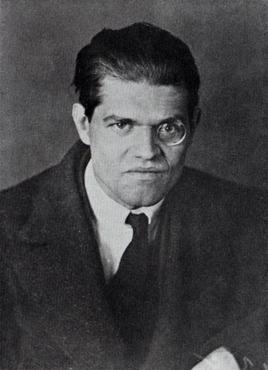
Raoul Hausmann was an Austrian artist and writer. One of the key figures in Berlin Dada, his experimental photographic collages, sound poetry, and institutional critiques would have a profound influence on the European Avant-Garde in the aftermath of World War I.

Nouveau réalisme is an artistic movement founded in 1960 by the art critic Pierre Restany and the painter Yves Klein during the first collective exposition in the Apollinaire gallery in Milan. Pierre Restany wrote the original manifesto for the group, titled the "Constitutive Declaration of New Realism," in April 1960, proclaiming, "Nouveau Réalisme—new ways of perceiving the real." This joint declaration was signed on 27 October 1960, in Yves Klein's workshop, by nine people: Yves Klein, Arman, Martial Raysse, Pierre Restany, Daniel Spoerri, Jean Tinguely and the Ultra-Lettrists, Francois Dufrêne, Raymond Hains, Jacques de la Villeglé; in 1961 these were joined by César, Mimmo Rotella, then Niki de Saint Phalle and Gérard Deschamps. The artist Christo showed with the group. It was dissolved in 1970.

Anti-art is a loosely used term applied to an array of concepts and attitudes that reject prior definitions of art and question art in general. Somewhat paradoxically, anti-art tends to conduct this questioning and rejection from the vantage point of art. The term is associated with the Dada movement and is generally accepted as attributable to Marcel Duchamp pre-World War I around 1914, when he began to use found objects as art. It was used to describe revolutionary forms of art. The term was used later by the Conceptual artists of the 1960s to describe the work of those who claimed to have retired altogether from the practice of art, from the production of works which could be sold.

Iris Clert was a Greek-born art gallery owner and curator. She owned the Iris Clert Gallery in Paris from 1955 to 1971. During its tenure, her gallery became an avant-garde hotspot in the international art scene, particularly to Yves Klein, Jean Tinguely and Arman.
Haptic poetry, like visual poetry and sound poetry, is a liminal art form combining characteristics of typography and sculpture to create objects not only to be seen, but to be touched and manipulated. Indeed, in haptic poetry, the sense of touch is equal to, if not more important than, the sense of sight, yet both text-based poetry and haptic poetry have the same goals: to create an aesthetic effect in the minds of the intended audience.
In the visual arts, late modernism encompasses the overall production of most recent art made between the aftermath of World War II and the early years of the 21st century. The terminology often points to similarities between late modernism and post-modernism although there are differences. The predominant term for art produced since the 1950s is contemporary art. Not all art labelled as contemporary art is modernist or post-modern, and the broader term encompasses both artists who continue to work in modern and late modernist traditions, as well as artists who reject modernism for post-modernism or other reasons. Arthur Danto argues explicitly in After the End of Art that contemporaneity was the broader term, and that postmodern objects represent a subsector of the contemporary movement which replaced modernity and modernism, while other notable critics: Hilton Kramer, Robert C. Morgan, Kirk Varnedoe, Jean-François Lyotard and others have argued that postmodern objects are at best relative to modernist works.
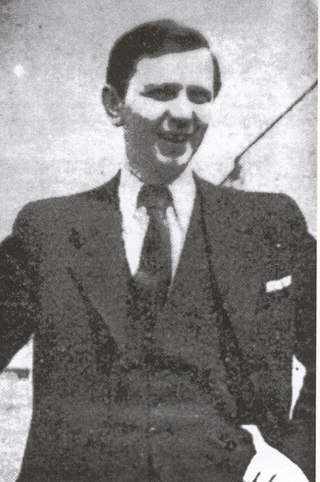
Dragan Aleksić was a Serbian Dadaist poet, author, journalist and filmmaker. He was the founder of the Yugoslavian branch of Dadaism, termed "Yugo-Dada".
Avant-garde art and American pop culture have had an intriguing relationship from the time of the art form's inception in America to the current day. The art form, which began in the early half of the nineteenth century in Europe, started to rise slowly in America under the guise of Dadaism in 1915. While originally formed under a group of artists in New York City who wanted to counter pop culture with their art, music, and literature the art form began to grow into prominence with American pop culture due to a variety of factors between the 1940s to the 1970s. However, from many factors that arose in the late 1970s, avant-garde began to both lessen in prominence and began to blend with the pop culture to the point in which most art critics considered the art form extinct.

Signalism represents an international neo-avant-garde literary and art movement. It gathered wider support base both in former Yugoslavia and the world in the late 1960s and the beginning of the 1970s.
Magazine Signal with the subtitle "International Review of Signalist Research" was the periodical of Signalism, international avant-garde creative movement. The magazine was founded in 1970 in Belgrade. Founder and editor-in-chief was Miroljub Todorović.
Neo-Dadaism Organizers, sometimes shortened to Neo-Dada Organizers or simply Neo-Dada (ネオ・ダダ), was a short-lived but influential Japanese Neo-Dadaist art collective formed by Masunobu Yoshimura in 1960. Composed of a small group of young, up-and-coming artists who met periodically at Yoshimura's "White House" atelier in Shinjuku, the Neo-Dada Organizers engaged in all manner of visual and performance artworks, but specialized in producing disturbing, impulsive spectacles, often involving physical destruction of objects, that the art critic Ichirō Hariu deemed "savagely meaningless," and that inspired another art critic, Yoshiaki Tōno, to coin the term "anti-art" (han-geijutsu). Examples included filling galleries with piles of garbage, smashing furniture to the beat of jazz music, and prancing the streets of Tokyo in various states of dress and undress. Using the human body as their medium of art, their violent performances reflected both their dissatisfaction with the restrictive environment of the Japanese art world at the time, as well as contemporary social developments, most notably the massive 1960 Anpo protests against the U.S.-Japan Security Treaty.

Dada Tank was a Yugoslav Dadaist single issue publication published in Zagreb in June 1922 and edited by Dragan Aleksić. Aleksić published Dada Tank as a response to Branko Ve Poljanski and his brother Ljubomir Micić's anti-Dada publication Dada-Jok from May 1922.

